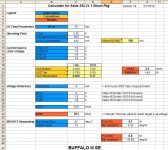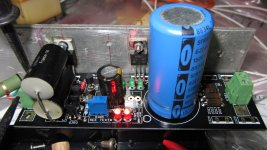Stajo will advise you on that, who has a stash of chokes to check out. Me I said use a cmult cascade at the output.
Sorry I was too late, but hey congrats, you solved it.
To make an after analyze, I would do a voltage check before and after the 317. It should kill your ripple better. Do you really have sufficient vdrop concerning both amps and temp in the datasheet? To that you must add at least the ripple level (PP/2 I think, not sure) before the 317.
Sorry I was too late, but hey congrats, you solved it.
To make an after analyze, I would do a voltage check before and after the 317. It should kill your ripple better. Do you really have sufficient vdrop concerning both amps and temp in the datasheet? To that you must add at least the ripple level (PP/2 I think, not sure) before the 317.
My voltage before 317 was 19.3v from Raw DC when amp connected. After 317, 13.8v stable. No heat on sink (about 30 deg C constantly).
My voltage before 317 was 19.3v from Raw DC when amp connected. After 317, 13.8v stable. No heat on sink (about 30 deg C constantly).
That should be fully satisfactory for it to bring home the bacon. A wild guess that you have between 0,7 and 1,0 vrms ripple before it and it should have no problem with bringing down that with 60-80 dB.
Harsh spikes from rectification tho can be another story. But now you have a working PSU to enjoy.
PS. My earlyer comments about voltage before and after choke assumed that the choke was first thing after rectification. On later pix I saw that was not the fact, so that can be ignored.
Last edited:
That should be fully satisfactory for it to bring home the bacon. A wild guess that you have between 0,7 and 1,0 vrms ripple before it and it should have no problem with bringing down that with 60-80 dB.
Harsh spikes from rectification tho can be another story. But now you have a working PSU to enjoy.
PS. My earlyer comments about voltage before and after choke assumed that the choke was first thing after rectification. On later pix I saw that was not the fact, so that can be ignored.
I'm fully satisfied (thanks to Salas) , but any way if you will use choke setup there (alternative way to emiter capmult) , then what values of choke would you suggest for such circuit?
Thank Salas for your quick reply ,
With +- 15VDC for Legato, Can I replace Q104, Q204 (BC550, BC560) by BC548B, BC558B ?.
Better not because they have worse noise figure spec.
I'm fully satisfied (thanks to Salas) , but any way if you will use choke setup there (alternative way to emiter capmult) , then what values of choke would you suggest for such circuit?
Well chokes in series is like everything else, ohms law. If your current is I=U/R=12/500 (bleeder) you have 24 mA to deal with and you just find a choke that takes the limit. Add the current of your devise and maybe 50 mA is a good one in your case. If you, like I first thought, use the choke as first element (L-C) in a filter chain, it has to deal with much larger ripple, and my approach is to at least double the current spec.
What comes up is: When you use a cap, large enough, as first devise, the voltage after rectification will be AC x sqr2 minus the voltage drop over each rectifier diode. In a greatz bridge its two diodes so its (AC x 1,41) minus (vdrop x 2. In your case (14 x 1,41) - (0,7 x 2) = 18,3 volt.
If you, on the other hand, puts the choke as first device, you will only get AC x 0,9 volts minus vdrop on diodes. You might win that some spikes from the rectifications that not gets enhanced by the first cap and further into the circuit.
It takes more voltage to start with tho. In tube circuits, where you might want 3-500 volts, it might be encumbering to make an L-C. In low voltage circuits tho, if you find good availiable chokes, its my first choce.
My fav circuits in tube circuits is usually a middle way: small cap-small inductor etc. You can set the voltage with the size of the first cap, and your noice pollution will be minimal.
Thanks Salas, Yes, making it ptp  .
.
Its between source and gnd. Gate goes to gnd too. Why? Making it point to point?
Well chokes in series is like everything else, ohms law. If your current is I=U/R=12/500 (bleeder) you have 24 mA to deal with and you just find a choke that takes the limit. Add the current of your devise and maybe 50 mA is a good one in your case. If you, like I first thought, use the choke as first element (L-C) in a filter chain, it has to deal with much larger ripple, and my approach is to at least double the current spec.
What comes up is: When you use a cap, large enough, as first devise, the voltage after rectification will be AC x sqr2 minus the voltage drop over each rectifier diode. In a greatz bridge its two diodes so its (AC x 1,41) minus (vdrop x 2. In your case (14 x 1,41) - (0,7 x 2) = 18,3 volt.
If you, on the other hand, puts the choke as first device, you will only get AC x 0,9 volts minus vdrop on diodes. You might win that some spikes from the rectifications that not gets enhanced by the first cap and further into the circuit.
It takes more voltage to start with tho. In tube circuits, where you might want 3-500 volts, it might be encumbering to make an L-C. In low voltage circuits tho, if you find good availiable chokes, its my first choce.
My fav circuits in tube circuits is usually a middle way: small cap-small inductor etc. You can set the voltage with the size of the first cap, and your noice pollution will be minimal.
Thank you for such detailed explanation.
So, in general if I use the choke 30 Ohm and then 4700uF C1 afrer rectifier , my frequency cutoff will be 1.13Hz. What about Henri?
In general, the greater inductance the better filtering. Thus, as with everything in life, excessive use can have bad sides. With increased inductance follows higher capacistance wich can cause other effects like interaction/oscillation with other components like capacitors. Choose a low value in the beginning and higher in the end of the filter chain.
Heres a little text about cap vs choke input filters:
Choke or Capacitor Input?
Heres a little text about cap vs choke input filters:
Choke or Capacitor Input?
- Home
- Amplifiers
- Power Supplies
- SSLV1.1 builds & fairy tales


 Post a picture of your diy if you got.
Post a picture of your diy if you got.